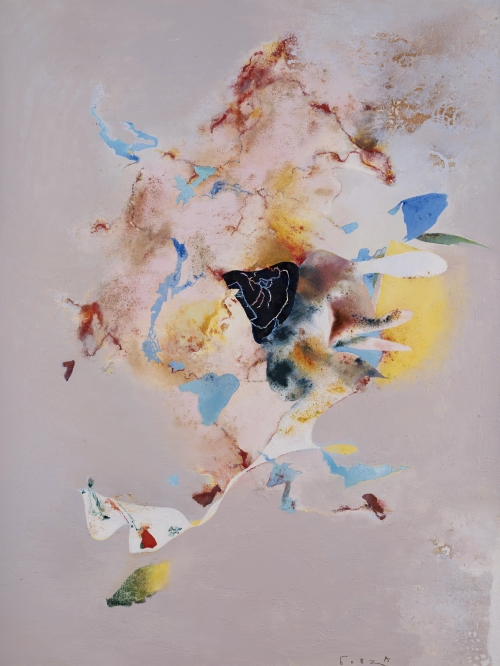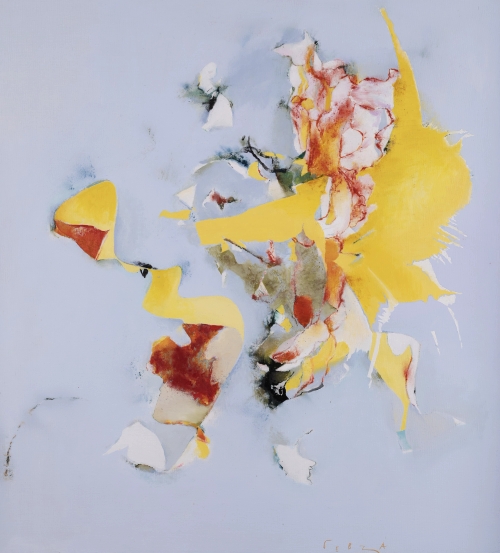Petro Bevza: Community, Land Art, and the Search for Identity and Continuity

Anna Avetova

Table of Contents
In the early 1990s, artists in Kyiv moved into abandoned apartment blocks to create art in new circumstances. This was where the BG Art community was founded—a lasting association that has existed since 1995 and now includes more than 60 artists, such as Badriy Hubianuriya, Yura Solomko, Vladyslav Shyrishevskyi, Oleksii Lytvynenko, Matvii Vaisberg, and others. One of its key members is Petro Bevza, who explores themes of space, continuity, and Ukrainian artistic identity.
BG Art isn’t a situational society as often happened before, but a stable structure that allows artists to think and grow together,
The exhibition “BG Art as a Community Right” presents works from the early 90s up to Lytvynenko’s piece of 2021, showing the evolution of artistic thought.
Land Art: Environment and Memory
Bevza thoroughly recalls the development of land art in Ukraine, highlighting its origins in the late 1980s (Oleksandr Babak, Hlib Vyshyslavskyi, Serhiy Yakunin, Hanna Sydorenko). He clarifies that Ukrainian land art did not emerge in reaction to international practices but was an expression of our own cordocentric philosophy.
Environmental art in Ukraine isn’t about transforming nature, as in the American land art tradition, but rather about attuning oneself to the processes already present in the soil. The task is not to disrupt, but to help viewers see the energies that already exist there,
He recalls his projects in Mohyritsia, which arose spontaneously through cooperation with space and its transformations—such as works with red clay or mirrors, which became part of the landscape. The artist stresses that love for Ukrainian soil, especially now as it is ravaged by war, could give new impetus to environmental art.

On Digitization of Art
Bevza expresses a positive attitude toward digitizing artistic archives and museum collections in general, as it creates a chance to continue a dialogue with one’s own past and with works whose locations may be unknown. He believes that projects like UFDA can help to extract what’s essential from the informational chaos, giving access not only to images, but to context as well.
Identity in a Global Context: Seeking, Challenges, and Continuity
When discussing Ukrainian art’s representation abroad, Bevza talks about the nuanced balance between activity and the absence of a "big collective offering."
There’s interest in Ukraine, especially since the beginning of the war, but we lack a single, holistic project that could be presented at the Pompidou or MoMA. We have many talented artists, but the comprehensive image is still forming,
Bevza emphasizes that identity in Ukrainian art is a process of constant transformation.
If we say it already exists, it disappears. Identity is born when we actively seek, experiment, when our artists and curators think on a grand scale and persistently work.
He compares this with the continuity of American abstraction and Ukrainian artistic traditions: In America, generations maintain dialogue and exchange, while in Ukraine, restoring that continuity remains an ongoing process. Bevza stresses that war has pushed many artists to rethink themselves, renew their often cordocentric identities, and rely on historical memory and creative heritage.
Our art is in a state of searching for continuity. For me, feeling a connection to artists of the past—Bohomazov, Boychuk, Meller—is vital. They provide support for the new generation. There’s a unique sense when you see old works and realize: this is mine, but created a hundred years ago,

Education, Tradition, and Academia
Petro Bevza analyzes the role of the academy as a place for sharing experience and creative support. He recounts the formative influence of workshops, teachers, and peers, specifically noting the impact of meeting Tiberiy Silvashi on his path.
The academy is, first of all, a community of like-minded people and strong teachers. It’s important that students can ask questions and get answers. This helps to form continuity, which young artists often lose.
Yet Bevza observes that contemporary artistic education in Ukraine lacks contact with international stars, as in Berlin or the US, where live dialogues are much more accessible.

Interaction, Generations, Continuation
For Bevza, art is an ongoing process of interaction—between generations of artists, between people and the environment, and between Ukraine and the world. He speaks about the huge importance of dialogue, openness, and courage in contemporary art—and shares how artists such as Vitalii Kokhan or Serhiy Radkevych are forming a new language, a new Ukrainian individualism.
There are many who repeat, but there are those who create honestly, from the heart and in a professional context. This is perhaps the best sign of artistic maturity—when the past becomes a resource for us, not a burden,
UFDA continues to document these dialogues, helping to form the artistic continuity for future generations and making memory, interaction, and technology a collective space for new Ukrainian art. Listen to the UFDA Podcast on Instagram, Spotify, Apple Podcasts, and YouTube.
